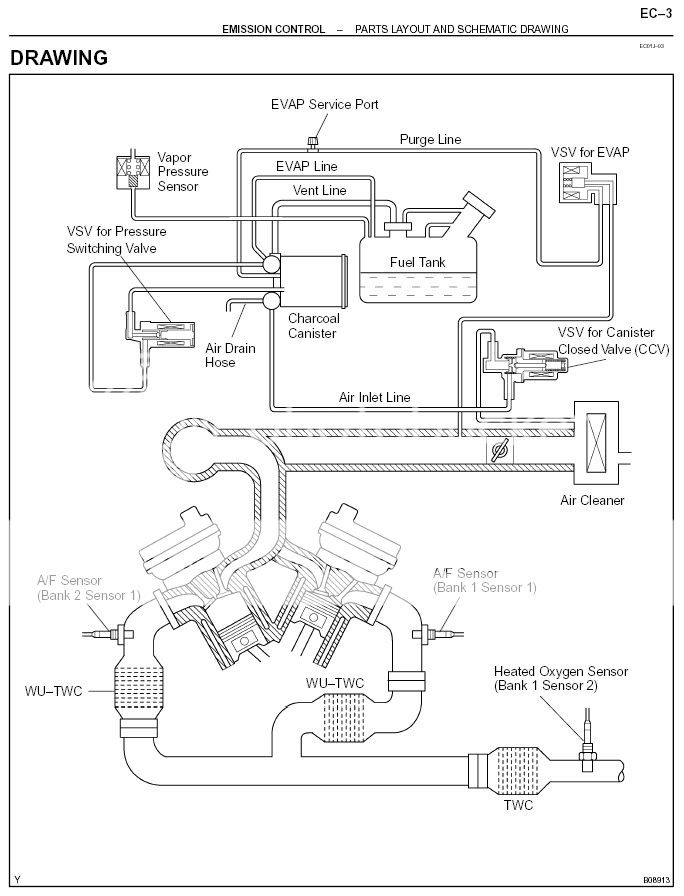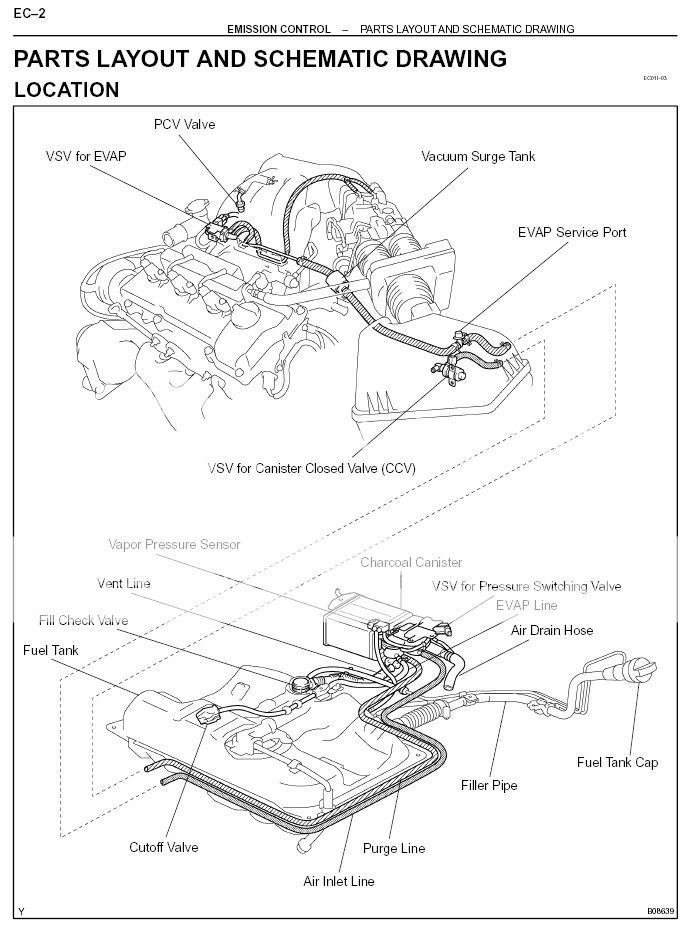code mystery solved
Thought I would share my experience tracking down root cause of this code.
P0440 = vacuum leak
There are many place to look.
1. I replaced all suspect hoses
2. checked all vacuum actuators with mityvac (they should all hold a vacuum, if not their junk)
3. checked all vsvs for proper operation 4 of these on car up front. 1 mounted on backside of air cleaner cleaner (normally open), 2 near fuel rail (2 the same type normally open), 3rd was suspect (should be normally closed [it is blue])
4. to fix the blue vsv I simply disasembled it and gave the spring a bit of a stretch. then reassembled and it worked like a charm.
5. The is another vsv located on the right side of the charcoal canister (located between gas tank and spare tire) This vsv also proved to be suspect testing with mityvac.
Replacing the rear vsv and fixing the blue vsv, solved the issue.
Note to test these use 2 wires and a switch from the battery, then connect wires to the vsvs.
The brown and black vsvs will not completely hold a vacuum the others will. the brown black simply divert air either through the round barrel like fiter on the end or to the output tube. The blue vsv, the one mounted to air cleaner and the one on the charcoal canister all hold vacuum when being tested.
Hope that helps someone.
You can also do a search for 'P0440 and vsv" for more info on Toyotanation.
I have had the P0440 problem on two of my cars and I have installed the VSV near the canister where it is only one bolt or nut and looking right at you. I think the part was $70 at the dealer. I am assuming your gas cap is a Toyota product.

It looks like the VSV Canister Closed Valve is the valve that switches off the air intake for a vacuum test. The VSV Evap is the purge line. I'm still not quite clear on what the VSV pressure switching valve does, but it is located on the canister. The other 2 valves are under the hood. I guess I'll test them with a 9 volt battery to make sure they are working and listen for the click of thesolenoid. I'd like to check the pressure sensor for about 1.5VDC with no vacuum and the filler cap off.

I think the pressure switching valve is actually to vent excessive pressure if triggered by the vapor pressure sensor. It does not allow air to flow through it unless it is powered.
The CCV valve I believe helps to maintain a vacuum in the evap canister and the fuel tank. I believe it opens to allow air inlet if the canister is actively purging. Then it closes just before the canister stops purging so there's a bit of vacuum in the system.
The CCV valve is the one that most likely has failed.
Hold up, have you even replaced the CCV valve yet? You should do that first before anything else. If you have successfully fixed the problem, the check engine light will go out on it's own.
I guess that wouldn't be a bad place to start because it's fairly inexpensive and looks easy to replace.
Most common failures are fuel caps and carbon canisters. It is a waste of time to just try and replace a vapor pressure sensor or, VSV as they come with the canister assembly. The non replaceable vent valves on the canister fail and leak. Have replaced lots of canisters and fuel caps. Hardly any CCVs or purge valves. If you live in the salt belt look for rusted hard lines in the system.
-----------
A simple fix is a loose or bad fuel cap - as if I would everget that lucky! One way I knew we had a leak is because that sucking sound when you remove the gas cap to refuel had stopped happening - another clue!
There are 3 electrically operated valves in the system - they only cost about $40 and are easy to replace.
Taking it to the dealer will result (almost certainly) in them NOT just replacing one of these - they will want
to change the whole canister - $325 parts + a million dollars labor of course. I cannot afford that so I started to look at mine
http://www.findonefindall.com/toyota-sienna/toyota_sienna_evap_P0446.htm
Mine, of course, was NOT the electrical valve VSV (Toyota Part # 90910-12264) -despite the P0446 code which specifies this.
I had a perforated or torn air valve at the front of the canister - which you cannot buy separately of course!
Here's a picture of them - they come off - but you cannot buy them on their own
- You have to buy a whole new canister $340 - Rats! Toyota Part # 77740-08042 (which replaced 77740-08041)
There are 3 electrically operated valves in the system - they only cost about $40 and are easy to replace.
Taking it to the dealer will result (almost certainly) in them NOT just replacing one of these - they will want
to change the whole canister - $325 parts + a million dollars labor of course. I cannot afford that so I started to look at mine
http://www.findonefindall.com/toyota-sienna/toyota_sienna_evap_P0446.htm
Mine, of course, was NOT the electrical valve VSV (Toyota Part # 90910-12264) -despite the P0446 code which specifies this.
I had a perforated or torn air valve at the front of the canister - which you cannot buy separately of course!
Here's a picture of them - they come off - but you cannot buy them on their own
- You have to buy a whole new canister $340 - Rats! Toyota Part # 77740-08042 (which replaced 77740-08041)
Things to check first if you are getting P0440, P0441, P0442, P0446
1) Make sure the gas cap is ON (and "clicks" ) and is the correct Toyota Gas Cap (aftermarket may not work). Clear the codes and run for a while. See if codes come back.
2) Make sure the tube to the electrical valve on the air cleaner is still on - Many clumsy oil change places pull these off accidentally (or on purpose- who knows?)
3) Test and inspect all the rubber lines under the hood and connecting to the canister.
4) Test the VSV Electrical valve on the canister - put 12V across it using 2 small alligator clips and wires (RadioShack) It should click and let air through.
5) Test the other 2 valves under the hood the same way (the one on the air cleaner works backwards i.e. Power = Block Airflow)
6) If you can - test the air valves (seen above) -
7) Bend over - get your wallet out and buy a new Charcoal canister - ouch! $300+ If you are still getting the "whoosh" on taking the cap off, maybe the Pressure sensor in the tank is bad.
1) Make sure the gas cap is ON (and "clicks" ) and is the correct Toyota Gas Cap (aftermarket may not work). Clear the codes and run for a while. See if codes come back.
2) Make sure the tube to the electrical valve on the air cleaner is still on - Many clumsy oil change places pull these off accidentally (or on purpose- who knows?)
3) Test and inspect all the rubber lines under the hood and connecting to the canister.
4) Test the VSV Electrical valve on the canister - put 12V across it using 2 small alligator clips and wires (RadioShack) It should click and let air through.
5) Test the other 2 valves under the hood the same way (the one on the air cleaner works backwards i.e. Power = Block Airflow)
6) If you can - test the air valves (seen above) -
7) Bend over - get your wallet out and buy a new Charcoal canister - ouch! $300+ If you are still getting the "whoosh" on taking the cap off, maybe the Pressure sensor in the tank is bad.
